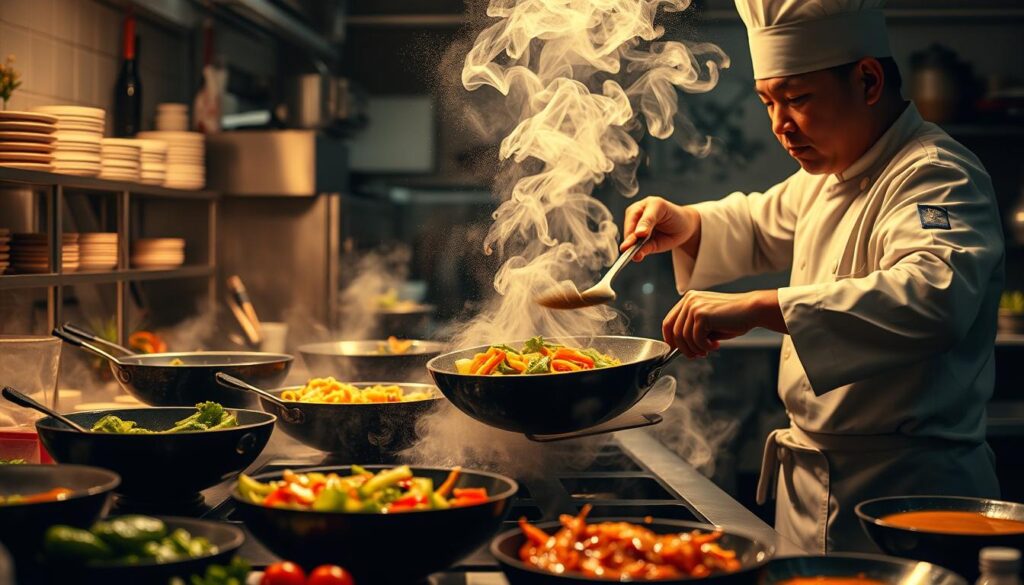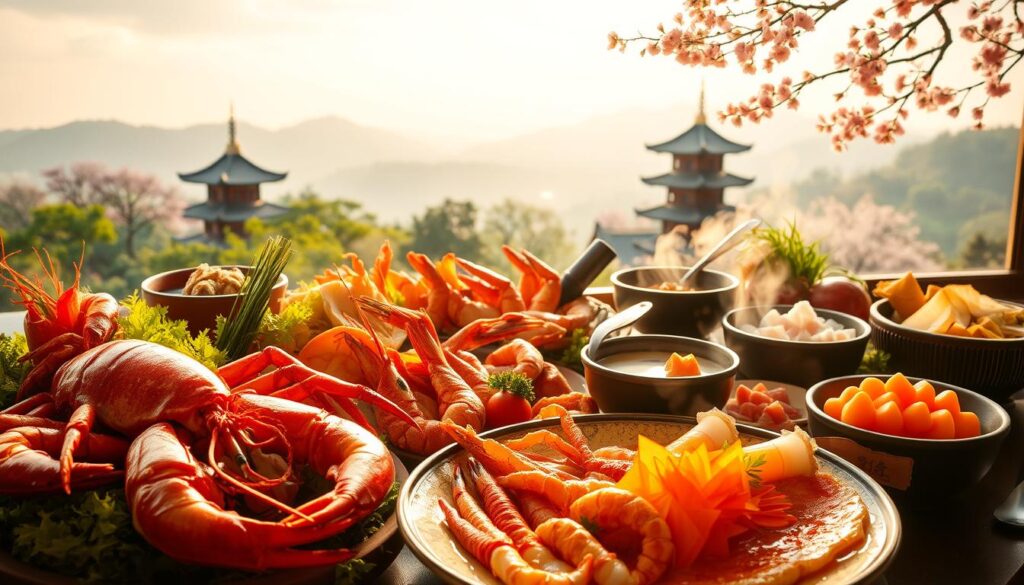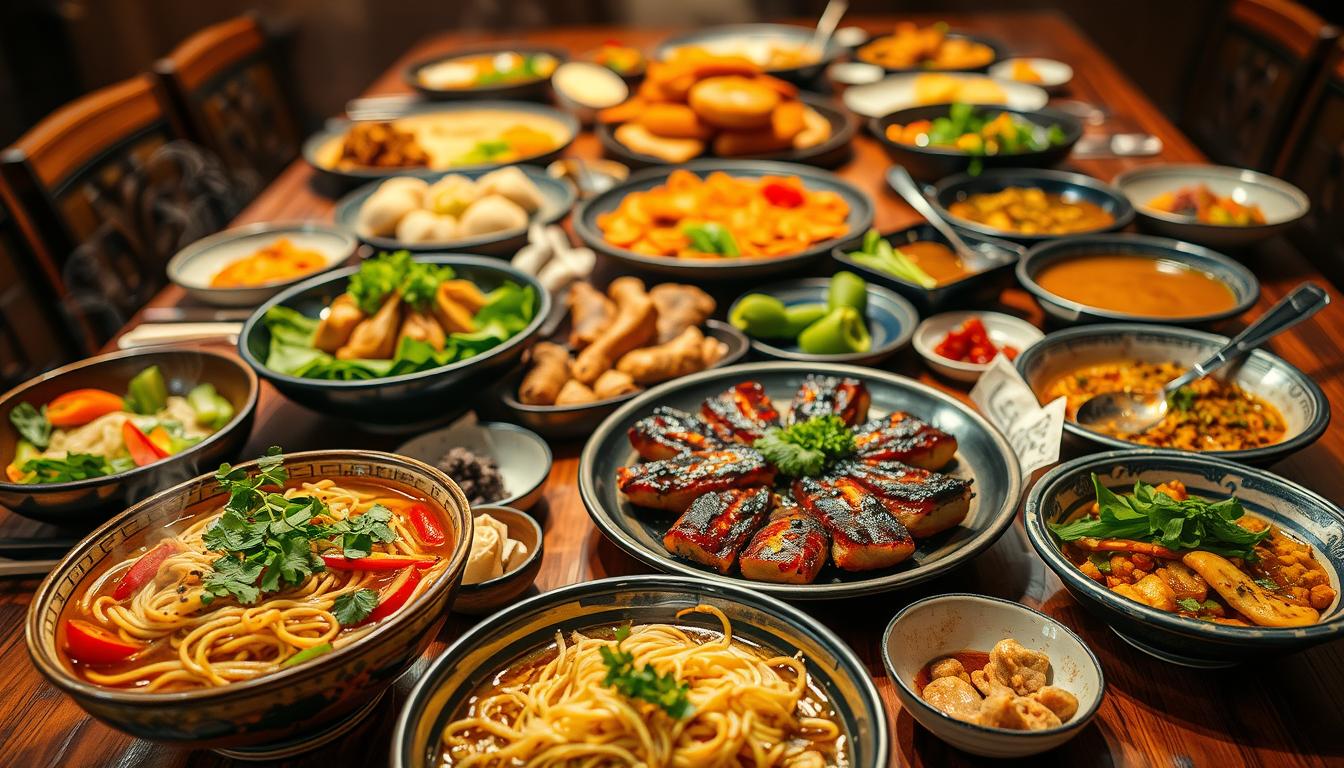Ever wondered how to make your weeknight dinner special? Asian cuisine offers a world of flavors that can turn your kitchen into a gourmet adventure. From Bangkok’s street food stalls to Tokyo’s fancy restaurants, oriental dinner recipes bring amazing taste and nutrition to your table.
Asian cuisine is more than just food; it’s a celebration of culture, health, and flavor. These meals are full of fresh veggies, lean proteins, and exciting seasonings. They make every bite a thrilling experience. Whether you’re busy or just want to try new recipes, these dishes will change how you see mealtime.
Our collection showcases unique parts of Asian culinary traditions. You’ll find dishes like Chinese dim sum, Korean pork belly, and Vietnamese summer rolls. These recipes are not only tasty but also very healthy, taking your dinner routine to new heights.
Key Takeaways
- Discover authentic Asian flavors that transform everyday meals
- Learn quick and healthy cooking techniques from Asian cuisine
- Explore diverse dishes from different Asian culinary traditions
- Understand the nutritional benefits of Asian-inspired recipes
- Master simple yet delicious oriental dinner preparation methods
Understanding Asian Culinary Traditions and Techniques
Exploring Asian culinary traditions shows the richness of international flavors. These diverse cooking methods turn exotic ingredients into amazing dishes. They delight our taste buds and connect cultures through food.
Essential Asian Cooking Methods
Asian cuisine is known for its unique cooking techniques. Stir-frying is a key method in Chinese and Thai cooking. It cooks food quickly, keeping nutrients and texture intact.
- Stir-frying: Quick, high-heat cooking technique
- Steaming: Preserves nutritional value
- Braising: Develops deep, complex flavors
- Smoking: Adds rich, aromatic dimensions
Must-Have Kitchen Tools for Asian Cooking
Having the right tools in your kitchen can change your cooking game. The right tools can make your dishes taste like they’re from a restaurant.
| Tool | Purpose | Cuisine Origin |
|---|---|---|
| Wok | High-heat cooking | Chinese |
| Bamboo Steamer | Gentle ingredient cooking | Chinese |
| Rice Cooker | Consistent rice preparation | Japanese |
Basic Flavor Profiles in Asian Cuisine
Getting flavor balance right is key to making authentic Asian dishes. The mix of sweet, sour, salty, and umami flavors creates complex tastes. These flavors are what make Asian cuisine so special.
“Cooking is about passion, and Asian cuisine embodies this through its complex flavor combinations.” – Chef Martin Yan
By learning these techniques and understanding flavor basics, you can make amazing Asian dishes at home.
Oriental Dinner Recipes for Quick Weeknight Meals
Busy home cooks can make weeknight dinners exciting with eastern delicacies. These meals are quick and full of flavor. They are perfect for when you’re short on time.
Here are some fast oriental dinner ideas to change your meal prep:
- Thai Peanut Noodles – Ready in just 10 minutes
- Thai Basil Chicken – Prepared in 15 minutes
- Chinese Beef and Broccoli Noodles – Completed in 20 minutes
- Garlic Chili Oil Noodles – Quick 10-minute meal
- Kimchi Fried Rice – A 15-minute wonder
“Cooking authentic Asian cuisine doesn’t have to be time-consuming or complicated.” – Chef Ming Tsai
These recipes show how easy it is to enjoy eastern delicacies. With a little planning and smart choices, you can make amazing meals fast.
Here are some tips for quick Asian cooking:
- Prep ingredients in advance
- Use pre-cut vegetables
- Keep essential sauces on hand
- Invest in a good wok
- Learn basic stir-fry techniques
Your weeknight meals will never be dull again. These fast, tasty oriental recipes offer speed, nutrition, and great flavor.
Mastering Asian Stir-Fry Dishes
Stir-frying is a key part of cross-cultural cooking. It turns simple ingredients into amazing dishes. This method lets you make restaurant-quality meals fast, mixing flavors and textures easily.

Stir-frying is more than just cooking. It’s about knowing how ingredients work together and quick cooking skills. Success comes from planning well and executing perfectly.
Perfect Stir-Fry Sauce Combinations
Making the perfect stir-fry sauce is all about balance:
- Salty components: Soy sauce, fish sauce
- Sweet elements: Palm sugar, honey
- Aromatic enhancers: Garlic, ginger
- Optional acid: Rice vinegar
Vegetable Preparation Tips
Getting your vegetables ready is key for stir-frying. Each veggie cooks differently:
- Hard vegetables (broccoli, carrots): 3-4 minutes
- Semi-hard vegetables (bell peppers, onions): 2-3 minutes
- Soft vegetables (snow peas, spinach): 1-1.5 minutes
Protein Selection Guide
Choosing the right protein for your stir-fry matters. Here’s a guide for thickness:
- Pork/Beef: ⅛ – ¼ inch thick
- Chicken: ½ inch pieces
- Fish: 1-inch chunks
- Tofu: Firm or extra-firm varieties
Stir-frying is more than a cooking method. It’s a journey that brings global food traditions together through creativity and taste.
Authentic Noodle and Rice-Based Dishes
Explore the world of oriental dinner recipes with authentic noodle and rice dishes. These dishes are more than just food. They are a journey through cultural traditions and flavors.
Noodle and rice dishes are at the heart of Asian cuisine. They offer incredible variety and depth. From delicate rice noodles to hearty wheat-based options, each type adds unique texture and flavor to your dinner.
Popular Noodle Varieties
- Rice noodles: Light and delicate
- Egg noodles: Rich and chewy
- Wheat noodles: Sturdy and versatile
- Glass noodles: Transparent and silky
When cooking these dishes, knowing the right techniques is key. Rice noodles need 25-30 minutes of soaking before cooking. Wheat noodles can go straight into boiling water.
| Noodle Type | Preparation Time | Calories per Serving |
|---|---|---|
| Lo Mein | 20 minutes | 508 kcal |
| Singapore Rice Noodles | 16 minutes | 339 kcal |
To make the best oriental dinner recipes, use quality ingredients and proper cooking techniques. Try different noodle types and sauces to make restaurant-quality meals at home.
“Noodles are the canvas, and your ingredients are the paint.” – Asian Culinary Wisdom
Pro tip: Stir-fry your ingredients quickly over high heat. This keeps texture and flavor locked in. Your homemade Asian noodle dishes will taste like they came from a professional kitchen!
Essential Asian Sauce and Marinade Recipes
Start your journey into international flavors with homemade Asian sauces. These treasures turn simple meals into special ones. They bring exotic ingredients and real tastes to your table.
Making your own sauces lets you pick what goes in. You can cut down on salt and make flavors just right for you. Whether you cook at home or love trying new recipes, learning these sauces will make your dishes better.
Homemade Teriyaki Sauce
Teriyaki sauce is a mix of sweet and savory. It’s easy to make and packs a lot of flavor.
- Preparation time: 5 minutes
- Yield: 1-1/4 cups
- Ingredients: 8 simple components
Classic Stir-Fry Sauce Nutritional Profile
| Nutrient | Per 2 Tablespoon Serving |
|---|---|
| Calories | 29 |
| Total Fat | 1.2g |
| Protein | 0.5g |
| Sodium | 339mg |
Dipping Sauce Varieties
Try different dipping sauces to change up your meals. From spicy chili sauce to sweet and tangy ones, these sauces add excitement to your dishes.
- Vegan and gluten-free options available
- Customizable heat and flavor levels
- Quick to prepare
Learning these sauce recipes opens up a world of flavors in your kitchen. Experiment, tweak, and dive into the rich world of Asian cooking.
Seafood Specialties from the East

Dive into the rich world of eastern delicacies. These dishes showcase the incredible diversity of seafood in Asian cuisines. Coastal regions have perfected the art of transforming fresh catch into extraordinary dishes.
Exploring these diverse culinary traditions reveals a stunning array of seafood preparations. From delicate sushi to spicy seafood curries, each recipe tells a unique story. It reflects regional flavors and cooking techniques.
- Korean seafood dishes rich in omega-3 fatty acids
- Fresh ingredients sourced from coastal markets
- Unique preparation methods that preserve natural flavors
- Nutritional benefits of seafood-based meals
Your culinary journey through Asian seafood specialties will uncover remarkable nutritional advantages. Omega-3 fatty acids found in these dishes contribute to heart health and cognitive function. This makes them both delicious and beneficial.
| Seafood Dish | Origin | Key Nutrients | Calories per Serving |
|---|---|---|---|
| Haemul Pajeon (Seafood Pancake) | Korea | Protein, Omega-3 | 390 |
| Sundubu Jjigae (Soft Tofu Seafood Stew) | Korea | Protein, Vitamins | 200 |
“Seafood in Asian cuisine is not just food; it’s a cultural expression of freshness, flavor, and tradition.”
When preparing seafood dishes, choose fresh ingredients. Master techniques like sautéing, simmering, and careful seasoning. Your goal is to enhance the natural flavors while keeping the delicate texture of the seafood.
Vegetarian Asian Dinner Options
Asian cuisine is full of vegetarian dishes that are both tasty and healthy. These dishes use plant-based ingredients and new cooking methods. They show how simple ingredients can become amazing meals.
Looking into vegetarian Asian cooking opens up a world of tasty dishes. You’ll see how tofu, mushrooms, and other plant-based foods can make meals as good as meat ones.
Tofu Preparation Methods
Learning how to prepare tofu is important for tasty vegetarian Asian dishes. Here are some key steps:
- Press tofu for 30 minutes to remove excess moisture
- Marinate in soy sauce and garlic for enhanced flavor
- Bake at 425°F for crispy exterior (approximately 30 minutes)
- Use a 14-ounce block of extra-firm tofu for best results
Mushroom-Based Dishes
Mushrooms add amazing umami flavors to Asian dishes. Try these recipes:
- Shiitake stir-fry with ginger and green onions
- Enoki mushroom soup with miso base
- Oyster mushroom lettuce wraps
Plant-Based Protein Alternatives
Explore these protein-rich ingredients for your vegetarian Asian dishes:
- Edamame (1 cup provides substantial protein)
- Tempeh with rich, nutty flavor
- Seitan for meat-like texture
By using these techniques and ingredients, you can make vegetarian Asian meals that are both healthy and delicious. Try different methods to find your favorite plant-based dinner options.
Fusion Asian Recipes for Modern Tastes
Cross-cultural cooking has changed how we enjoy food, bringing new global food fusion ideas to our kitchens. Modern cooks are mixing Asian flavors with fresh cooking styles.
Starting your fusion cooking journey can turn simple meals into amazing dishes. It’s all about mixing different cooking methods to create dishes that excite your taste buds.
- Experiment with unexpected ingredient combinations
- Learn cross-cultural cooking techniques
- Balance traditional and contemporary flavor profiles
- Use local ingredients with Asian cooking methods
Knowing the health side of fusion recipes helps you make better choices. Here’s a detailed look at what you might find in a recipe:
| Nutritional Metric | Average Value |
|---|---|
| Calories per Serving | 366 calories |
| Protein Content | 27g protein |
| Fat Content | 11g fat |
| Carbohydrates | 40g carbohydrates |
Start your global food fusion journey by making dishes that tell a story. Your kitchen becomes a place where old Asian recipes meet new cooking ways. This leads to exciting and delicious dishes.
Health-Conscious Asian Cooking Methods
Asian cuisine is full of healthy cooking techniques. These methods can make your meals both tasty and nutritious. Traditional dishes offer many ways to enjoy food while keeping it healthy.
Low-Carb Alternatives for Asian Dishes
Looking for low-carb options in Asian food doesn’t mean losing flavor. You can make your favorite dishes healthier with a few simple swaps:
- Replace rice with cauliflower rice
- Use zucchini noodles instead of traditional wheat noodles
- Opt for lettuce wraps instead of wheat-based wrappers
Healthy Cooking Techniques
Many Asian cooking methods help keep nutrients in and fats low. Steaming, grilling, and light stir-frying make meals both tasty and healthy.
“Cooking is about passion, so it may look slightly temperamental in a way that it’s too assertive to some, but I don’t think it’s different from painting or music or literature.” – Robia Scott
Nutritional Benefits of Asian Ingredients
Asian cuisine is rich in ingredients that are good for you. Foods like omega-3 fish, antioxidant veggies, and herbs are full of nutrients. They help keep you healthy.
- Seafood dishes contain heart-healthy omega-3 fatty acids
- Vegetables preserve up to 90% of nutrients when steamed
- Fermented foods like kimchi support gut health
By using these healthy Asian cooking methods, you can make meals that are both delicious and good for you.
Essential Asian Ingredients Guide
Exploring international flavors starts with knowing the unique ingredients of Asian cuisine. Your cooking will change when you learn about the key parts that make Asian dishes authentic.
Asian cooking’s foundation is built on essential ingredients. They add depth and complexity to every dish. Make sure to have these items in your pantry:
- Soy Sauce Varieties: From light Thai soy sauce to rich Japanese alternatives
- Vinegars: Rice vinegar and specialized Asian vinegar blends
- Oils: Sesame oil, which adds distinctive nutty flavors
- Herbs and Spices: Fresh and dried options like lemongrass and galangal
Knowing the details of these ingredients can make your cooking better. For example, Thai fish sauce adds a deep umami flavor. Palm sugar gives a sweetness unlike regular sugar.
How you store and choose these ingredients is key. Many Asian ingredients need special care to keep their flavor. Refrigeration is best for herbs and sauces to keep their taste.
Pro tip: When trying new ingredients, start with small amounts. This helps you get better at cooking Asian dishes.
Your cooking journey is just starting with these essential Asian ingredients. They’re ready to make your meals unforgettable.
Serving and Presentation Tips for Asian Meals
Mastering the art of serving Asian cuisine is more than just cooking. It’s about creating a memorable dining experience. Your presentation can turn simple dishes into extraordinary moments.
Asian dining traditions focus on visual appeal and balance. They teach us that food presentation is an art that engages all senses. The way you arrange and serve dishes can make the meal more enjoyable.
Traditional Plating Techniques
When plating Asian meals, keep these principles in mind:
- Create visual balance with strategic food placement
- Use asymmetrical arrangements for dynamic presentations
- Select plates that complement the dish’s colors and textures
- Leave negative space to highlight individual ingredients
Garnishing Methods
Garnishes are key in Asian cuisine, adding both visual appeal and flavor. Fresh herbs, edible flowers, and vegetable carvings can make a simple dish stunning.
Table Setting Customs
Asian table settings reflect rich cultural traditions. Here are some tips:
- Provide chopsticks and optional Western utensils
- Use serving platters that encourage family-style dining
- Incorporate traditional decorative elements like red and gold accents
- Create a welcoming atmosphere that celebrates sharing
By embracing these presentation techniques, you’ll create memorable dining experiences. These experiences honor the depth and beauty of Asian culinary traditions.
Conclusion
Your journey through Asian cuisine has opened a world of flavors and techniques. Oriental dinner recipes are more than food; they’re a cultural experience. They turn your kitchen into a place of international flavors.
These recipes show the versatility and ease of Asian cooking. From quick stir-fries to detailed traditional dishes, they are accessible to everyone. You’ve learned that Asian cooking can be both easy and complex.
Exploring Oriental cuisine is more than cooking. It’s about understanding traditions, ingredients, and cooking methods. Whether making a Thai Green Curry or Vietnamese Spring Rolls, you’ve found that Asian cooking is versatile. It offers many vegetarian options, quick recipes, and varied flavors.
As you continue your culinary journey, remember that Asian cuisine is always changing. Each recipe shares a story of culture, family, and new cooking techniques. By adding these dishes to your meals, you’re not just eating. You’re making connections, trying new tastes, and growing your cooking skills.
Keep trying new things, stay curious, and enjoy the journey of finding oriental dinner recipes. They can make your meals special and exciting.
FAQ
What are the key differences between various Asian cuisines?
How can I make Asian cooking more accessible for beginners?
Are oriental dinner recipes typically healthy?
What are some essential tools for Asian cooking?
How can I substitute ingredients in Asian recipes?
What are the most common cooking techniques in Asian cuisine?
How can I make vegetarian Asian dishes flavorful?
What are some tips for perfect stir-frying?
How do I balance flavors in Asian cooking?
What are some beginner-friendly oriental dinner recipes?
Try Thes Recipes Next!
if you’re looking for more delicious recipes, check out our guide for another
crowed-pleasing dish

